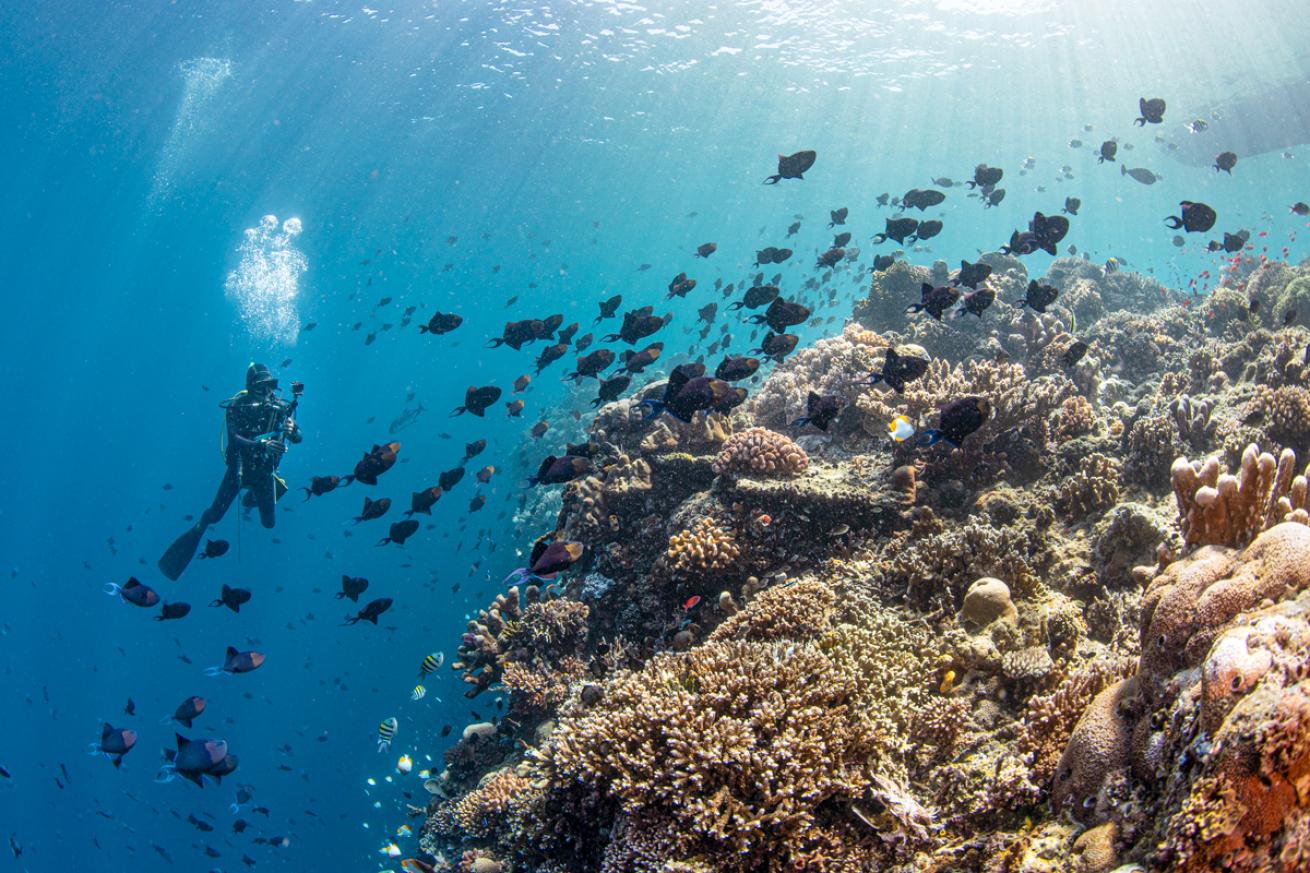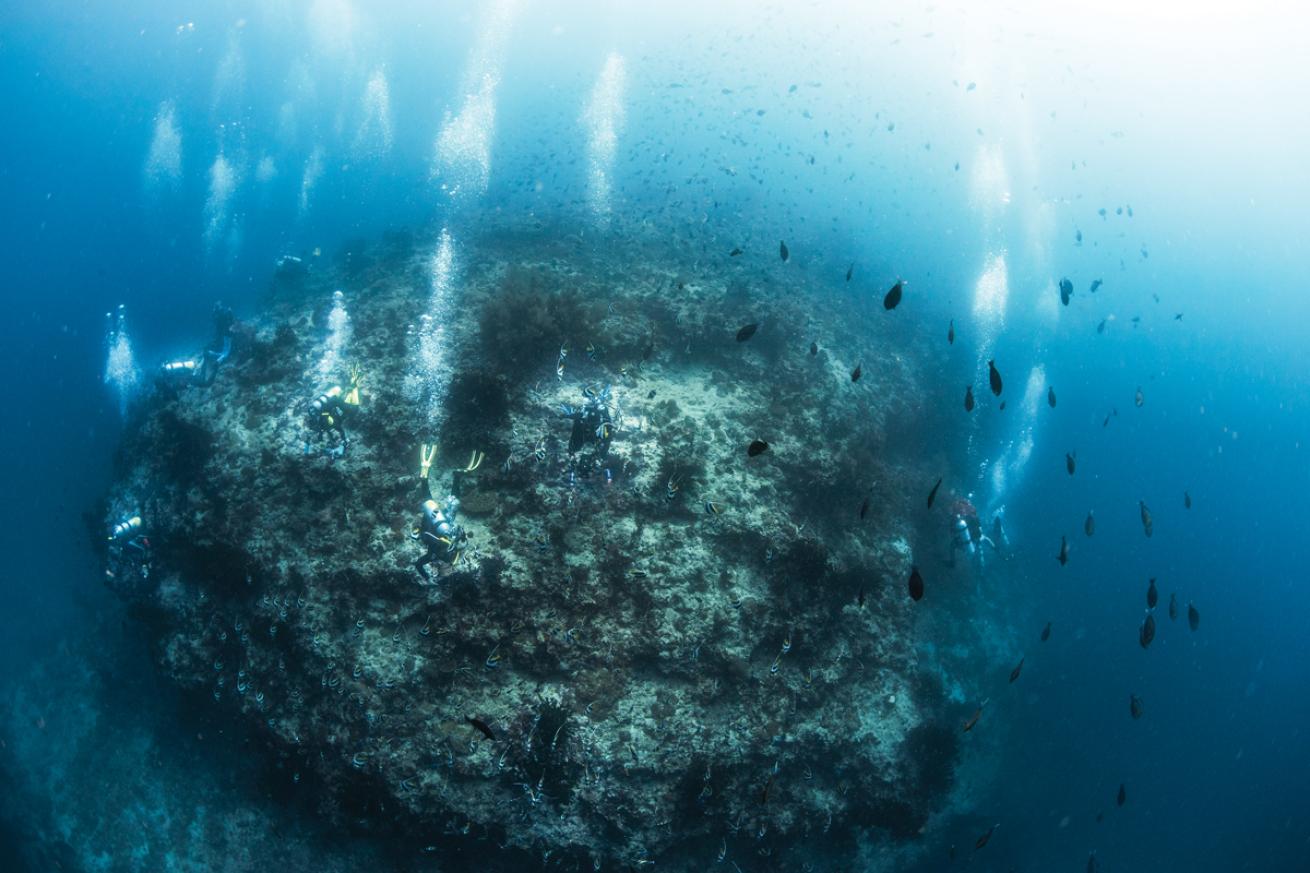How to Stay Warm Diving in Any Water Temperature

Annie CrawleyDivers can experience cold upwellings at sites such as this one in Indonesia. Pack layers and a hood if headed to Bunaken National Park or Lembeh Strait in North Sulawesi.
Your physical fitness, body composition, nutrition and thermal gear determine how much heat you retain while diving. Because water conducts heat away from the body 25 times faster than air, divers run the risk of hypothermia if they aren’t properly equipped, which can affect your decision-making ability and energy levels even in relatively warm water. Whether you’re diving in tropical, temperate or polar waters, these tips will help you stay warm underwater.
Pre-Dive Warming Hacks
When prepping for a dive day, consider what you need before and after diving. For each dive day, I pack a wind-resistant, fleece-lined dive coat, warm hat, ski gloves, hand warmers, rain coat, baseball hat and clothes for layering. For cold-water diving, I toss in a thermos full of hot water to warm my gloves and hood before diving, and to hydrate with hot drinks after. The same kit comes with me to the tropics, minus the ski gloves and hand warmers. The dive coat doubles as my blanket on the plane.
Knowing when to put on layers, or take them off, is key to heat regulation. Much of your heat escapes through your head—up to 20 to 40 percent of your warmth—so having layers and a warm hat for between dives helps to maintain your core temperature.
Diet also plays an integral role in retaining body heat. Eat foods that fuel your body, avoiding excess caffeine, alcohol and smoking as these affect blood flow and can make you colder. Protect yourself from the sun with reef-safe sunscreen and clothing with UV protection. If you get a sunburn, donning your dive kit will be painful, and you will feel colder underwater.
What To Wear
Your suit acts as a barrier between your body and the water. It should be made of quality neoprene and should fit snugly. Too tight and you’ll feel suffocated; too loose and water will flow through the suit, making you colder. Reinforced seams and a good neck seal help prevent unwanted water flow. Use thick socks with full-foot fins or boots with fins for extra insulation. Pay attention to sizing and specs. There’s a big difference in men’s and women’s sizing. Neoprene also varies in type (open-cell or closed-cell), stretch and buoyancy. Work with your local retail dive center to help you choose the best suit.
Water temperatures often fluctuate 10 degrees between winter and summer diving, and air temperatures can fluctuate even more dramatically. The neoprene thickness you choose should be suitable for the temperatures you’ll encounter. Avoid buying used wetsuits and neoprene drysuits. Over time, neoprene is compressed through deep diving and broken down by UV light. Even if the suit looks brand new, it may not keep you as warm as you think. Buy quality neoprene. Not all brands are equal. Cheaper neoprene is rough on your skin and doesn’t have the same thermal capability.
To figure out what thermal protection you need, consider depth, dive time, number of dives, days of diving and underwater activities. If you’re diving with thicker neoprene than usual, make sure to do a buoyancy check on your first dive.

Annie CrawleyDivers should avoid even mild hypothermia as it impacts decision-making and energy levels. Pack layers when multiday diving in warm-water locations such as the Maldives.
Consider using a thicker suit when moving slowly underwater, such as when muck diving or shooting. If you get cold on a deep dive, head into the warmer shallows where your suit is not compressed as much, which creates a thicker barrier.
When diving wet, bring extra bathing suits and rash guards. Between dives, get out of your wetsuit and change into dry clothes to stay warm. Dry your hair and put on a hat. Pack a variety of layering options, including hood, gloves, a heated wetsuit vest or undergarments for drysuit diving. When I am cold-water diving, I breathe air into my mask more frequently to warm my nose and face, and move my fingers in a gripping motion to circulate the blood in my hands.
Drysuit diving is not just for cold water anymore. With new lightweight materials and many different options for layering, you can stay warmer in tropical waters by switching to a drysuit. When you get cold, you off-gas more slowly due to how the blood flows, so you may carry a larger nitrogen load and be at a greater risk for DCS. Being cold also impacts how you breathe. Set your dive computer more conservatively and make longer safety stops to compensate for this. You may also feel more tired than usual after cold-water diving. The PADI Enriched Air Diver course trains you to breathe air with an increased level of oxygen, which reduces the risk of DCI.
There’s nothing worse than feeling cold when diving, especially when it can be avoided. When you can stay warm no matter what the temperature of your dive, the entire ocean opens up to you.
A Guide To Dive Gear by Temperature
| >85°F (29°C) | Divers who run warm: Bathing suit, rash guard or skin; Divers who run cold: 1-3 mm full wetsuit or drysuit |
| 80-84°F (26-28°C) | Divers who run warm: 1-3 mm shorty or full wetsuit; Divers who run cold: 3-5 mm full wetsuit or drysuit, 3-5 mm socks or boots |
| 70-79°F (21-25°C) | Divers who run warm: 3-5 mm full wetsuit, 3 mm gloves, 3 mm beanie or hood, 3 mm socks or boots; Divers who run cold: 5-7 mm full wetsuit, semi-dry wetsuit with heated vest or drysuit, 3-5 mm gloves, 5 mm hooded vest or hood, 5 mm boots |
| 62-69°F (16-20°C) | Divers who run warm: 5-7 mm full wetsuit or semi-dry wetsuit with heated vest, 3-5 mm gloves and boots; Divers who run cold: Semi-dry wetsuit and heated vest or drysuit with undergarments, 5 mm gloves, 5-7 mm hood and boot |
| 50-61°F (10-15°C) | Divers who run warm: Semi-dry wetsuit with heated vest or drysuit with undergarments, 7 mm hood; Divers who run cold: Drysuit with arctic undergarments, dry gloves, 11 mm hood |
| Below 50°F (Below 10°C) | Divers who run warm: Drysuit with undergarments or heated undergarments, 11 mm hood, dry gloves, cold-water regulator; Divers who run cold: Drysuit with heated undergarments, 11 mm hood, dry gloves, cold-water regulator |










